Abstract
In this paper, we present a new maximum power point tracking (MPPT) algorithm that can identify whether a boost converter is operating in continuous conduction mode (CCM) or discontinuous conduction mode (DCM). The conventional MPPT algorithm assumes that the converter is always in CCM mode, even though this is not always the case. The converter can enter DCM mode due to factors such as the inductor size, irradiance and temperature conditions, voltage step size of the algorithm, and operating point of the PV array. In the proposed work, the conduction mode of a boost converter is evaluated under different conditions. The region of the I–V curve where the converter is likely to operate in DCM mode is identified and a mathematical expression developed in this work is then used to detect the conduction mode of the converter. The proposed algorithm incorporates this expression into a modified perturb and observe () algorithm. In each iteration, the algorithm first detects the conduction mode of the converter. If the converter is in DCM mode, the algorithm takes a large voltage step to force the converter back into CCM mode, i.e., into the constant current region. The proposed MPPT algorithm was tested using simulation experiments, and the results show that the proposed algorithm can significantly improve the efficiency of the MPPT process.
1. Introduction
Photovoltaic (PV) systems are utilized in a wide range of applications, ranging from powering up calculator circuitry to the grid-connected systems with several MW of output power. The output of PV systems is dependent on weather conditions; thus, it is imperative to operate the photovoltaic system at the optimal energy point to avoid increasing the payback time.
Current PV systems are of two major types, i.e., grid-connected and standalone [1,2,3,4,5,6,7]. Most current PV systems are grid-connected system that use the concept of energy trading. Energy trading is based on a net metering scenario wherein the user sells excess electricity to the utility [8].
The generalized idea of a grid-connected PV system is depicted in Figure 1 [9]. Depending on the power electronics topology, it may be a single stage or a multiple power processing solution. Figure 1 shows a two-stage grid-connected PV system in which a PV array is connected to a dc–dc converter which tracks the MPP. The output of the dc–dc converter is then connected to an inverter which produces AC output with the desired voltage and frequency [10]. Various PV architectures exists to realize a grid-connected inverter. These include single-stage, dual-stage and multi-stage power processing [11,12]. Systems can be attached in a microgrid to fulfill neighborhood capacity. For larger systems, the use of string inverters and a central inverter is preferred [13,14].

Figure 1.
A generic PV system for AC load or grid connection.
Standalone PV systems, on the other hand, work without needing to be connected to a grid, and are capable of supplying electricity in the absence of a grid using excess energy stored in a battery [15,16]. This implies that the requirement of energy storage is imperative for such PV solutions. The most widely recognized setup for a standalone PV system involves a PV array, charge regulator, predetermined load, and battery storage [9], as shown schematically in Figure 2. The load should be part of the PV system’s design in order to ensure that the required capacity can be met under all climatic conditions. When the load profile is variable, a hybrid framework can be utilized.
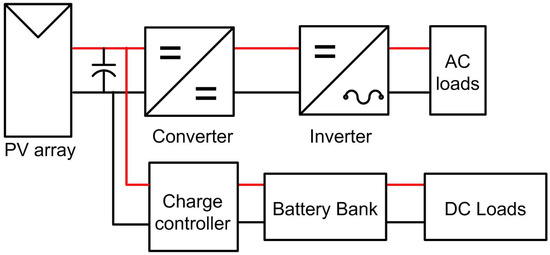
Figure 2.
A generic standalone PV system.
Along with the numerous benefits of PV systems, there are associated drawbacks, such as the initial high capital cost of PV plants, the low conversion efficiency of PV cells, and the unique MPP point on the I–V curve, which varies with weather condition. In light of these constraints, MPP algorithms are commonly installed in PV system in order to extract maximum power from the PV modules and deliver it to the load. Because MPP algorithms work through power electronic converters, the efficient operation of the power converter in terms of the conduction mode, i.e., continuous conduction mode (CCM), must be ensured as well.
Numerous MPPT algorithms have been proposed in the past [17]. The nature of these algorithms involves the following mechanisms: simple , hybrid algorithms, parametric estimation-based MPP methods, artificial intelligence schemes, meta-heuristic algorithms, and bio-inspired methods. A variable step size-based method was presented in [18,19] for MPP tracking. These algorithms though achieve better performance than ; however, they do not sense the conduction mode of converter, and always assume the dc–dc converter is in CCM. In [20], a fractional short-circuit scheme was used with a algorithm. Under various weather conditions, the algorithm [20] achieved better dynamic and steady-state efficiencies compared to . The major downside of this algorithm is the need to install an extra switch in dc–dc converter, which increases its hardware complexity.
Using the Lyapunov control scheme, in [21] the authors estimated a PV system’s parameters using an MPP algorithm. Their proposed scheme delivers good results; however, the implementation of the extensive mathematical expressions involved in the parametric estimations is not straightforward, and a high-tech embedded system is required for the installation of such a scheme. To improve the performance of fractional open-circuit voltage (FOCV) MPPT, a genetic algorithm (GA) was utilized in [22]. This algorithm, although able to increases the performance of FOCV, concurrently increases the computation burden of the system due to the GA. An ANN-based MPPT method using ripple correlation current (RCC) was presented in [23]. Again, this method requires a large amount of computational power for its practical realization. A metaheuristic-based robust unified control MPPT algorithm was presented in [24]. The high performance of this algorithm relies on a highly complex algorithmic mechanism, however, resulting in increased computation burden. Note that all the aforementioned MPP algorithms work with a converter, and do not employ any mechanism to detect whether the converter is in continuous conduction mode (CCM) or discontinuous condition mode (DCM).
When a dc–dc boost converter is installed in a PV system, the design of the converter’s components, operating points on the I–V curve, MPPT algorithm, and control aspects are set up in accordance with the continuous conduction mode of the converter. In this regard, the novelty of the present research work is as follows:
- We present an extensive investigation of a converter in DCM under conditions of varied weather and design of the components, which has not been previously well studied in the literature. The findings of this investigation indicate that there are several conditions during which converter enters DCM mode because of nonlinear characteristics of the PV source.
- This paper proposes a new method, in which a unique feature is introduced to restrict the converter’s movement into DCM. Mode identification of CCM and DCM is executed through a unique formula, and no new sensors are required to execute this process.
- Compared to previous algorithms, the proposed method results in the converter not becoming caught in DCM mode, and as such is better able to utilize PV-generated power.
2. Related Work
A dc–dc converter works in continuous conduction mode (CCM) for most applications, although occasionally it may operate in discontinuous conduction mode (DCM) [25,26,27]. The operation of a dc–dc converter in DCM is primarily due to low loading conditions; however, in a PV system environmental conditions may force the system to shift into DCM. Moreover, PV systems are designed to operate in MPPT mode using a dc–dc converter, sometimes called as regulator. Based on an algorithm, the regulator accepts inputs such as photovoltaic voltage () and current () and sets the desired duty cycle (D) to ensure that the PV array delivers the maximum power. The underlying principle of MPPT is the implementation of maximum power transfer theorem, wherein the dc–dc converter matches the source and load impedance to maximize the power transfer.
The impact of the operating mode of a dc–dc converter on system performance has always been an area of interest for researchers [28]. In this regard, our literature review revealed that the transition from CCM to DCM for a PV-fed pumping station was studied in [29]. Similarly, the transition of a buck-boost dc–dc converter between CCM and DCM was expounded in [30]. The authors in [31] argued that the system can be made to work smoothly in a mixed conduction mode with a fuzzy controller and a fixed switching frequency. Other researchers have included the converter operation in the modeling phase of the converter [32]. However, all of the presented works have only discussed CCM and DCM in terms of the load. In this paper, we suggest the theory explaining the impact of irradiance on the dc–dc converter has not been fully developed, and that the converter may operate in DCM mode even if the load is kept constant. Therefore, we propose a solution wherein the impact of irradiance on the dc–dc converter is first evaluated, then added to the maximum power point tracking algorithm.
3. Analysis of Boost Converter
A DC–DC boost converter, as shown in Figure 3, works in two modes based on the characteristics of the inductor current. When the switch ‘S’ is turned ON, the inductor current builds up, indicating that the energy is stored in the inductor ‘L’. When switch ‘S’ is tuned OFF, the inductor becomes connected to the load. Because the inductor behaves as a current source, it preserves its voltage polarity in this mode to maintain the current in the same direction. During this process, the inductor current drops, indicating that energy is transferred to the load. During CCM mode, the inductor current never falls to zero, and volt-second balance is maintained during both ON time ‘’ and OFF time ‘’ of the converter. As is well known, the critical or minimum value of an inductor for staying in CCM mode can be designed based on Equation (1):
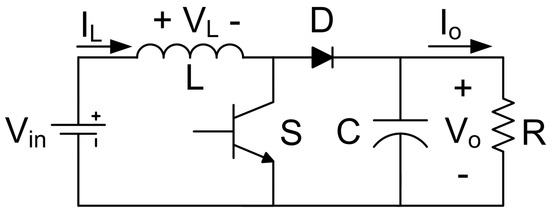
Figure 3.
Circuit of a dc–dc boost converter.
4. Design of Boost Converter for a PV Array
The inductor value can be determined by Equation (4):
where is the voltage corresponding to the MPP, is the maximum power point current, X% is the percentage ripple component of , and is equivalent to DT (or ). Here, the duty cycle ‘D’ is determined through Equation (5). Note that higher inductor values cause stable output current due to the reduced ripple component.
The output capacitor value can be determined from Equation (6), where is the output voltage ripple.
5. Boost Converter CCM/DCM Mode Analysis with Variations in L and Weather Conditions
The design and operation of the inductor ‘L’ and its effect on different portions of the I–V curve through D plays an integral part in the conduction modes of a boost converter. Moreover, the operation of a dc-dc converter in CCM or DCM is impacted by irradiance and temperature variations due to the change in the I–V characteristics of the PV array [33].
To analyze the impact on the operational mode of the boost converter, a PV system can be analyzed for different inductor ‘L’ values versus variations in weather conditions and different operating points of the I–V curve. In this study, the first inductor value is estimated through Equation (4) and installed in the boost converter. Then, irradiance and temperature conditions are configured at certain values. Under these specific weather conditions, the PV array settings for different operating points on the I–V curve are established, i.e., from the short-circuit current ‘’ point to the open-circuit voltage ‘’ point, using variations in D (0 to 1). At each operating point, the operation of the boost converter in CCM mode or DCM mode is identified. Finally, the operating points when the PV array is under the influence of DCM mode are marked on the I–V curve of the PV array. Note that this loop is repeated for different values of the inductor ‘L’, where for every inductor value the irradiance is varied from 1000 to 100 at 0 °C, 25 °C, and 50 °C temperature values and operation in CCM or DCM is evaluated against each operating point on the I–V curve. The details of the PV array and simulation setup are explained in the upcoming section.
In this context, Figure 4 represents the system behavior at 1000 to 100 when temperature is fixed at 25 °C, where the inductor is designed through Equation (4) at a ripple current of 40% of in Figure 4a, 20% of in Figure 4b, and 10% of in Figure 4c. The marks on the I–V curves in each of these figures indicate the converter’s operation in DCM mode. The same simulation experiment was repeated excluding the temperature variaton, which was set at 0 °C; the resulting I–V curves are displayed in Figure 5. Likewise, Figure 6 shows the I–V curves when the temperature was set at 50 °C.

Figure 4.
I–V curves at different irradiance conditions at 25 °C with inductor designed at (a) 40% of , (b) 20% of , and (c) 10% of .

Figure 5.
I–V curves at different irradiance conditions at 0 °C with inductor designed at (a) 40% of , (b) 20% of , and (c) 10% of .

Figure 6.
I–V curves at different irradiance conditions at 50 °C with inductor designed at (a) 40% of , (b) 20% of , and (c) 10% of .
Through these studies and subsequent graphical analysis, the following findings were established and used as the basis for developing the MPP algorithm:
- At high irradiance values, if the converter is operating in the constant current region or MPP zone, the converter stays in CCM. However, if it moves towards the Voc region, the converter enters DCM.
- At low irradiance values, i.e., from 250 and below, the converter may operate in DCM mode even in the MPP region due to the low source current from the PV array.
- In general, the P&O algorithm starts the first run from the region, i.e., in DCM mode. This means that if the algorithm is operating with a low voltage step it may become confused in this region, resulting in low convergence speed and poor dynamic efficiency.
- Because the P&O algorithm continues to searching the MPP under varying weather conditions, it may enter the DCM region frequently, potentially disrupting MPP tracking if it becomes caught in this region for several iterations.
6. Design of the Proposed MPPT Technique
Keeping in view the findings established in the previous section, the design of the algorithm is described in this section.
6.1. Identification Mechanism of CCM/DCM
When the boost converter operates in CCM mode, the volt-second product of the inductor current during and is the same, leading to the voltage relation presented in Equation (7):
This relation is rearranged in Equation (8), where represents the input voltage when the PV array is connected to the input of boost converter:
When the converter enters DCM, the voltage transfer relation presented in (7) becomes invalid. The converter now starts working with the different voltage relation of DCM, as expressed in Equation (9):
where k is the dead-time period during which the inductor current becomes zero and is the load resistance.
Note that the MPP embedded system contains the ‘D’ value, while the and values are taken from sensors. During every iteration, the proposed algorithm first estimates using Equation (10):
where the D and values are taken from the memory of the embedded system. Thereafter, this value is compares with the value measured by the sensor. If the and values match (with a degree of tolerance to account for sensor sensitivity), this means that algorithm is in CCM, as it is working with the CCM relation. When does not match the , this implies that algorithm is in DCM. As a corrective measure, the algorithm then triggers a sizeable negative voltage step such that PV array moves towards the MPP or current region and the converter starts operating in CCM again.
6.2. Functioning of Proposed MPPT
The flowchart of the proposed algorithm is shown Figure 7. The inputs to the algorithm are and , based on which the instantaneous photovoltaic power is calculated. Following the conventional algorithm, the proposed algorithm then compares the stored photovoltaic power with the instantaneous PV power. Then, the proposed algorithm decides the positive or negative direction of a new voltage step in the same way as and sets the value of D. Before moving to a new iteration, the proposed algorithm estimates the value and measures the value to identify whether the converter is in CCM or DCM, as explained in previous section. If the calculated and measured values are less than a limit ‘’, then the converter is considered to be operating in CCM and the conventional is maintained. If it is not within this limit, the system is considered to be operating in discontinuous mode. When DCM operation is detected, the duty cycle is changed by adding an arbitrary value to ensure that it returns to continuous mode operation. In this work, this arbitrary value is set at 0.25 and, the positive step in D leads to a negative step in .
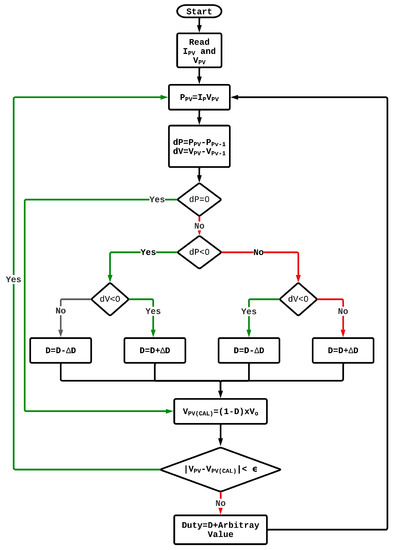
Figure 7.
Flow Chart of the proposed MPPT technique.
7. Simulation Experiments and Comparative Study
7.1. PV Module in PSIM
Simulations of proposed technique were carried out in PSIM software, which is considered one of the best platforms to test PV systems with power electronic interfacing architectures. Figure 8 shows the specifications of the PV module utilized in the simulation environment of the proposed architecture. The P–V curve of the module is traced from 0 V to open-circuit voltage in STC condition, the characteristics of which are displayed in Figure 9.
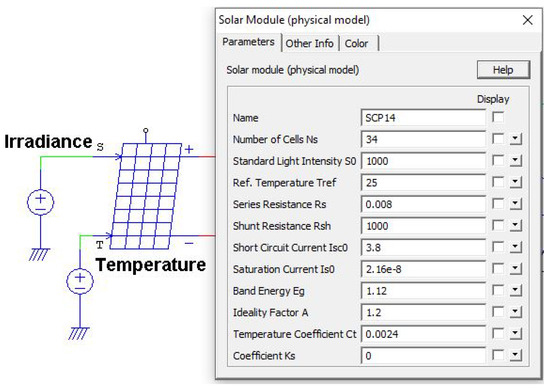
Figure 8.
Specifications of the PV Module.
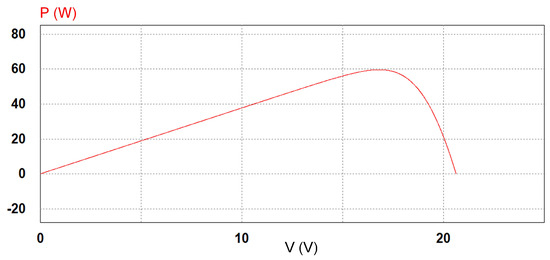
Figure 9.
P–V Curves for PV Module.
7.2. Case 1
Figure 10 presents the graph when the PV array is operating in CCM mode and STC condition. It can be seen that the inductor current does not reach the zero value. More importantly, the signal value of the calculated matches the measured value. Note that the duty cycle is fixed at a certain value and that the algorithm is not initiated to validate the proposed working model for identifying CCM and DCM operation.
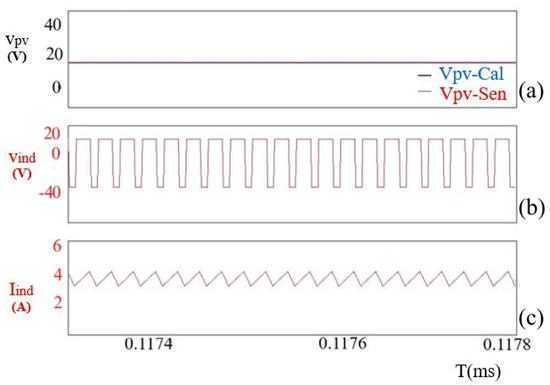
Figure 10.
Waveforms in Continuous Conduction Mode: (a) instantaneous photovoltaic voltage, (b) voltage across the inductor, and (c) current passing through the inductor.
Next, the duty cycle was set at the value where the PV system starts operating in DCM mode, the waveforms of which are shown in Figure 11. It can be seen that the inductor current becomes discontinuous as it reaches 0 A. Operation in DCM can be detected based on the difference in values between the calculated and measured . These results confirm that the identification of CCM and DCM using the proposed method is accurate.
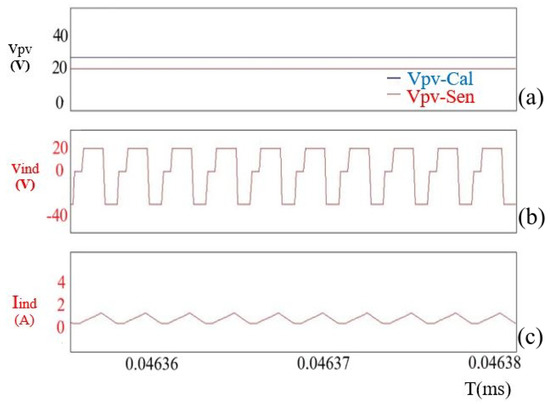
Figure 11.
Waveforms in Discontinuous Conduction Mode: (a) instantaneous photovoltaic voltage, (b) voltage across the inductor, and (c) duty cycle.
Next, to validate the MPP operation and convergence speed of the proposed algorithm and conventional algorithm, both systems were initially set to the open-circuit voltage of the PV module. Figure 12 shows the performance of the conventional algorithm; it can be seen that it requires several voltage steps to reach the MPP point. This is because the conventional becomes caught in the DCM of the converter. On the contrary, the effective operation of proposed method can be confirmed from Figure 13, where it can be seen that proposed methods needs only few steps to identify DCM operation. Thereafter, it reaches the MPP in fewer steps compared to the conventional algorithm. This simulation experiment indicates the high convergence speed and high efficiency of the proposed method.
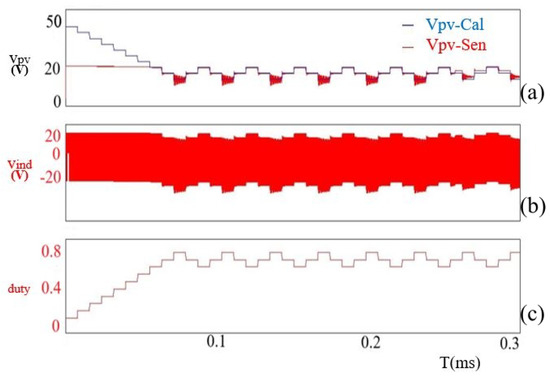
Figure 12.
Usual operation of the algorithm: (a) instantaneous photovoltaic voltage, (b) voltage across the inductor, and (c) duty cycle.
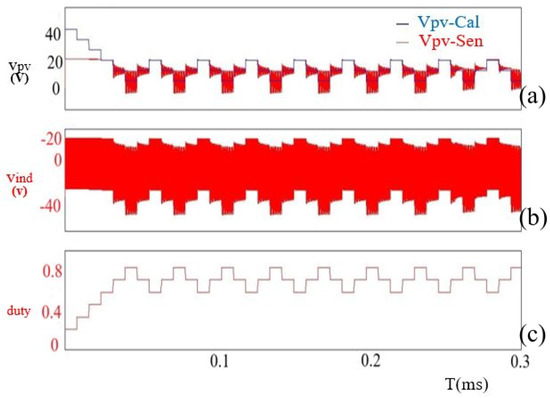
Figure 13.
Exceptional operation of the proposed modified algorithm: (a) instantaneous photovoltaic voltage, (b) voltage across the inductor, and (c) duty cycle.
The time requirements of the proposed algorithm and conventional algorithm in CCM and DCM are provided in Table 1.

Table 1.
Time comparison of proposed and conventional algorithms.
7.3. Case 2
In another experiment, both algorithms were allowed to reach the MPP point. In this manner, both converters operated in CCM mode during the starting phase, as shown in Figure 14 and Figure 15. Next, the irradiance conditions were varied at 0.1 ms and the operation of both converters was observed in terms of the MPP tracking of the PV system. The irradiance condition was reset to 1000 at 2 ms.
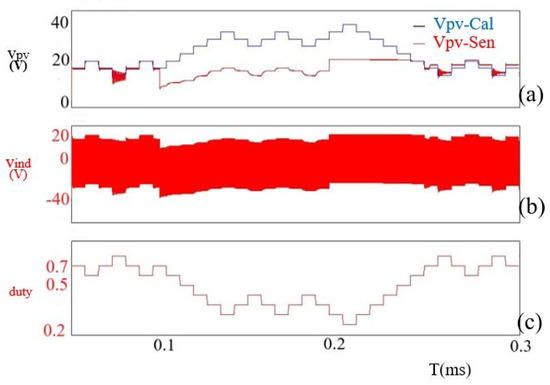
Figure 14.
Usual Operation of algorithm under varying irradiance: (a) instantaneous photovoltaic voltage, (b) voltage across the inductor, and (c) duty cycle.
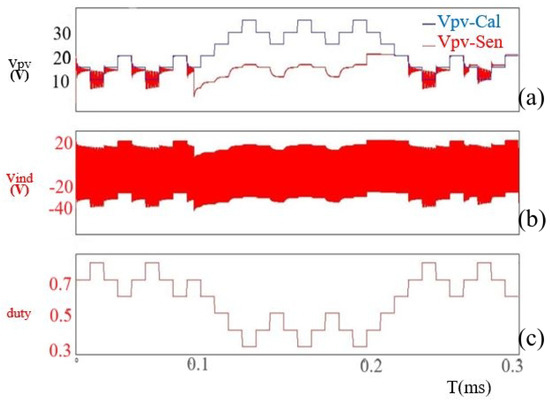
Figure 15.
Exceptional operation of the proposed modified algorithm under varying irradiance: (a) instantaneous photovoltaic voltage, (b) voltage across the inductor, and (c) duty cycle.
Figure 14 indicates that during the experiment with variations in irradiance, for the PV system with the conventional algorithm the converter enters discontinuous mode at 0.1 ms and returns to CCM mode at 0.265 ms, which was when the irradiance returned to 1000 at 0.2 ms. This clearly depicts that the conventional algorithm requires several iterations and a considerable time to return to MPP after entering DCM, compromising the convergence speed and dynamic efficiency of the system. In contrast, the performance of the PV system with the proposed method under the same test is displayed in Figure 15. Similarly, the proposed algorithm enters DCM due to variations in weather conditions after 0.1 ms; however, it does not diverge from the MPP point by a large margin compared to the conventional . Moreover, it attains the MPP point after only 0.22 ms when the irradiance returns back to 1000 at 0.2 ms. In summary, the proposed method outscores and outperforms the conventional algorithm in terms of both convergence speed and the dynamic efficiency of the PV system.
Table 2 shows the time requirements from the simulation results for the conventional and proposed algorithms operating in continuous and discontinuous modes.

Table 2.
Time comparison of proposed and conventional algorithms.
8. Discussion: Qualitative Comparison between MPPTs
A qualitative analysis between multiple MPPTs is presented in Table 3. It is evident that, apart from the proposed MPPT, no other algorithm is capable of detecting the operating mode of the converter, while the proposed algorithm retains all the advantages of .

Table 3.
Qualitative comparative analysis between MPPT methods.
9. Conclusions
The MPP operation of a PV system is inevitable because of the high capital cost and low energy conversion efficiency of PV modules. In this paper, the algorithm has been studied with special reference to the converter’s operation in DCM mode. The study of DCM operation of converters and its relationship with MPPT performance are very uncommon in the literature. In an attempt to bridge this gap, the present paper provides a detailed analysis of the problems posed by DCM operation. Further to this, it discusses a remedial measure in the form of a modified algorithm. In this work, we suspected that DCM operation of a dc–dc converter might be a fairly frequent phenomenon, as the conduction mode of a PV-fed converter depends on factors such as inductor size, weather conditions, and the operating point on the I–V curve. Therefore, the proposed algorithm incorporates an identification mechanism to detect the conduction mode of a dc–dc converter. The proposed algorithm follows the conventional algorithm if the converter is detected as operating in CCM. When the converter is found to be operating in DCM, the proposed algorithm suggests a higher value of the duty ratio that will return it to CCM operation. Through experiments, we determined that the convergence speed and dynamic efficiency of a PV system using the proposed MPPT approach is significantly improved compared to the conventional algorithm.
Author Contributions
Conceptualization, A.M.N., H.S.S. and A.F.M.; Methodology, A.M.N., H.S.S. and A.F.M.; Software, A.M.N., H.S.S., A.F.M., M.H.A. and A.S.A.; Validation, A.M.N., A.F.M., S.Z.A. and A.S.A.; Formal analysis, A.M.N., H.S.S., A.F.M., S.Z.A., M.H.A. and A.S.A.; Investigation, M.H.A.; Writing–original draft, A.M.N., H.S.S. and A.F.M.; Writing–review & editing, S.Z.A., M.H.A. and A.S.A.; Project administration, A.M.N., S.Z.A., M.H.A. and A.S.A. All authors have read and agreed to the published version of the manuscript.
Funding
This research was funded Deputyship for Research & Innovation, Ministry of Education in Saudi Arabia, Grant Number IF2/PSAU/2022/01/23150.
Institutional Review Board Statement
Not applicable.
Informed Consent Statement
Not applicable.
Data Availability Statement
No new data were created or analyzed in this study. Data sharing is not applicable to this article.
Acknowledgments
The authors extend their appreciation to the Deputyship for Research & Innovation, Ministry of Education in Saudi Arabia for funding this research work through the project number (IF2/PSAU/2022/01/23150).
Conflicts of Interest
The authors declare no conflict of interest.
Abbreviations
The following abbreviations are used in this manuscript:
| Limit used in the algorithm | |
| k | Dead time period during which the inductor current becomes zero |
| CCM | Continuous Conduction Mode |
| Step size of the duty ratio D | |
| D | Duty ratio |
| DCM | Discontinuous Conduction Mode |
| Switching frequency | |
| PV current corresponding to the maximum power point | |
| Instantaneous photovoltaic current | |
| Short-circuit current of the PV module | |
| I–V | Current vs. voltage characteristics |
| L | Inductor used in the dc–dc converter |
| Minimum inductance to ensure CCM mode | |
| MPP | Maximum Power Point |
| MPPT | Maximum Power Point Tracking |
| Perturb and Observe MPPT algorithm | |
| P-V | Power vs. voltage characteristics |
| PV | Photovoltaic |
| Load resistance | |
| Output voltage ripple | |
| Inductor voltage | |
| Output voltage | |
| Open-circuit voltage of PV module | |
| Estimated value of | |
| Instantaneous photovoltaic voltage | |
| STC | Standard testing condition (1000 , 25 °C) |
| ON time of the mosfet used in the dc-dc converter |
References
- Rekinger, M.; Thies, F.; Masson, G.; Orlandi, S. Global Market Outlook for Solar Power 2015–2019 Solar Power Europe; Report; SolarPower Europe: Brussels, Belgium, 2015. [Google Scholar]
- Díaz, M.; Muñoz, J.; Rivera, M.; Rohten, J. A Comprehensive Control Strategy for a Push–Pull Microinverter Connected to the Grid. Energies 2023, 16, 3196. [Google Scholar] [CrossRef]
- Al Abri, W.; Al Abri, R.; Yousef, H.; Al-Hinai, A. A Design of Partial Shading Detection Method and Global Power Point Searching Technique for Grid-Connected PV System Operating Under Partial Shading Condition. In Proceedings of the 2023 IEEE PES Conference on Innovative Smart Grid Technologies-Middle East (ISGT Middle East), Abu Dhabi, United Arab Emirates, 12–15 March 2023; pp. 1–7. [Google Scholar]
- Agrawal, S.; Umanand, L. A Novel Converter using MPPT Algorithm and Acceleration Factor for Stand-alone PV System. 2023. under review. [Google Scholar]
- European Photovoltaic Industry Association. Global Market Outlook for Photovoltaics 2014–2018; European Photovoltaic Industry Association: Brussels, Belgium, 2014. [Google Scholar]
- Sher, H.A.; Murtaza, A.F.; Addoweesh, K.E.; Chiaberge, M. Pakistan’s progress in solar PV based energy generation. Renew. Sustain. Energy Rev. 2015, 47, 213–217. [Google Scholar] [CrossRef]
- Tabassum, M.; Kashem, S.B.A.; Siddique, M.B.M.; Afrouzi, H.N.; Ponnan, S.; Sharif, H.Z. Renewable energy adoption in third world countries. Int. J. Eng. Syst. Model. Simul. 2022, 13, 255–261. [Google Scholar] [CrossRef]
- Hussain, H.M.; Nardelli, P.H. A heuristic-based home energy management system for demand response. In Proceedings of the 2020 IEEE Conference on Industrial Cyberphysical Systems (ICPS), Tampere, Finland, 9–12 June 2020; Volume 1, pp. 285–290. [Google Scholar]
- Pearsall, N. Introduction to photovoltaic system performance. In The Performance of Photovoltaic (PV) Systems; Elsevier: Amsterdam, The Netherlands, 2017; pp. 1–19. [Google Scholar]
- Sher, H.A.; Addoweesh, K.E.; Al-Haddad, K. An efficient and cost-effective hybrid MPPT method for a photovoltaic flyback microinverter. IEEE Trans. Sustain. Energy 2017, 9, 1137–1144. [Google Scholar] [CrossRef]
- Said Adouairi, M.; Bossoufi, B.; Motahhir, S.; Saady, I. Application of fuzzy sliding mode control on a single-stage grid-connected PV system based on the voltage-oriented control strategy. Results Eng. 2023, 17, 100822. [Google Scholar] [CrossRef]
- Naddami, S.; Ababssi, N.; Mokhlis, M. Nonlinear Control of a Three-Phase, Double-Stage Grid-Tied Photovoltaic System. In Proceedings of the 3rd International Conference on Electronic Engineering and Renewable Energy Systems: ICEERE 2022, Saidia, Morocco, 20–22 May 2022; Springer: Berlin/Heidelberg, Germany, 2023; pp. 441–449. [Google Scholar]
- D’silva, S.; Zare, A.; Shadmand, M.B.; Bayhan, S.; Abu-Rub, H. Towards Resiliency Enhancement of Network of Grid-Forming and Grid-Following Inverters. IEEE Trans. Ind. Electron. 2023. [Google Scholar] [CrossRef]
- Morey, M.; Gupta, N.; Garg, M.M.; Kumar, A. A comprehensive review of grid-connected solar photovoltaic system: Architecture, control, and ancillary services. Renew. Energy Focus 2023, 45, 307–330. [Google Scholar] [CrossRef]
- Sher, H.A.; Rizvi, A.A.; Addoweesh, K.E.; Al-Haddad, K. A single-stage stand-alone photovoltaic energy system with high tracking efficiency. IEEE Trans. Sustain. Energy 2016, 8, 755–762. [Google Scholar] [CrossRef]
- Anjum, W.; Husain, A.R.; Abdul Aziz, J.; Fasih ur Rehman, S.M.; Bakht, M.P.; Alqaraghuli, H. A robust dynamic control strategy for standalone PV system under variable load and environmental conditions. Sustainability 2022, 14, 4601. [Google Scholar] [CrossRef]
- Ahmad, R.; Murtaza, A.F.; Sher, H.A. Power tracking techniques for efficient operation of photovoltaic array in solar applications–A review. Renew. Sustain. Energy Rev. 2019, 101, 82–102. [Google Scholar] [CrossRef]
- Kollimalla, S.K.; Mishra, M.K. Variable perturbation size adaptive P&O MPPT algorithm for sudden changes in irradiance. IEEE Trans. Sustain. Energy 2014, 5, 718–728. [Google Scholar]
- Bhattacharyya, S.; Samanta, S.; Mishra, S. Steady output and fast tracking MPPT (SOFT-MPPT) for P&O and InC algorithms. IEEE Trans. Sustain. Energy 2020, 12, 293–302. [Google Scholar]
- Sher, H.A.; Murtaza, A.F.; Noman, A.; Addoweesh, K.E.; Al-Haddad, K.; Chiaberge, M. A new sensorless hybrid MPPT algorithm based on fractional short-circuit current measurement and P&O MPPT. IEEE Trans. Sustain. Energy 2015, 6, 1426–1434. [Google Scholar]
- Hussain, A.; Garg, M.M.; Korukonda, M.P.; Hasan, S.; Behera, L. A parameter estimation based mppt method for a pv system using lyapunov control scheme. IEEE Trans. Sustain. Energy 2018, 10, 2123–2132. [Google Scholar] [CrossRef]
- Hassan, A.; Bass, O.; Masoum, M.A. An improved genetic algorithm based fractional open circuit voltage MPPT for solar PV systems. Energy Rep. 2023, 9, 1535–1548. [Google Scholar] [CrossRef]
- Noman, A.M.; Khan, H.; Sher, H.A.; Almutairi, S.Z.; Alqahtani, M.H.; Aljumah, A.S. Scaled Conjugate Gradient Artificial Neural Network-Based Ripple Current Correlation MPPT Algorithms for PV System. Int. J. Photoenergy 2023, 2023, 8891052. [Google Scholar] [CrossRef]
- Manas, M.; Dakka, O.; Sharma, S.; Arandhakar, S.; Kallelapu, R.; Golla, S. A novel metaheuristic-based robust unified control MPPT algorithm for grid-connected PV system. Electr. Power Syst. Res. 2023, 221, 109389. [Google Scholar] [CrossRef]
- Murtaza, A.F.; Sher, H.A.; Khan, F.U.; Nasir, A.; Spertino, F. Efficient mpp tracking of photovoltaic (pv) array through modified boost converter with simple smc voltage regulator. IEEE Trans. Sustain. Energy 2022, 13, 1790–1801. [Google Scholar] [CrossRef]
- Ahmed, N.; Sher, H.A.; Al-Durra, A.; Hasanien, H.M. Comprehensive analysis and design of a switched-inductor type low inductance-requirement DC-DC buck-boost converter for low power applications. IET Power Electronics 2023, 16, 1239–1254. [Google Scholar]
- Murtaza, A.F.; Sher, H.A. A Series Resonant Network based Boost Converter. In Proceedings of the 2023 International Conference on Emerging Power Technologies (ICEPT), Swabi, Pakistan, 6–7 May 2023; pp. 1–4. [Google Scholar]
- Raghavendra, K.V.G.; Zeb, K.; Muthusamy, A.; Krishna, T.; Kumar, S.V.P.; Kim, D.H.; Kim, M.S.; Cho, H.G.; Kim, H.J. A comprehensive review of DC–DC converter topologies and modulation strategies with recent advances in solar photovoltaic systems. Electronics 2019, 9, 31. [Google Scholar] [CrossRef]
- Mudlapur, A.; Ramana, V.V.; Damodaran, R.V.; Balasubramanian, V.; Mishra, S. Effect of partial shading on PV fed induction motor water pumping systems. IEEE Trans. Energy Convers. 2018, 34, 530–539. [Google Scholar] [CrossRef]
- Nagarjun, S.; Debnath, D.; Chakraborty, C. Buck-boost buck CCM-DCM converter for PV based DC standalone system. In Proceedings of the 2018 IEEE International Conference on Power Electronics, Drives and Energy Systems (PEDES), Chennai, India, 18–21 December 2018; pp. 1–6. [Google Scholar]
- Agorreta, J.L.; Reinaldos, L.; Gonzalez, R.; Borrega, M.; Balda, J.; Marroyo, L. Fuzzy switching technique applied to PWM boost converter operating in mixed conduction mode for PV systems. IEEE Trans. Ind. Electron. 2009, 56, 4363–4373. [Google Scholar] [CrossRef]
- Basha, C.H.; Murali, M. A new design of transformerless, non-isolated, high step-up DC-DC converter with hybrid fuzzy logic MPPT controller. Int. J. Circuit Theory Appl. 2022, 50, 272–297. [Google Scholar] [CrossRef]
- Adeel, M.; Sher, H.A.; Hassan, A.K.; Al-Haddad, K. Comparative Analysis of PV Parameter Extraction Algorithms. In Proceedings of the IECON 2022—48th Annual Conference of the IEEE Industrial Electronics Society, Brussels, Belgium, 17–20 October 2022; pp. 1–6. [Google Scholar]
Disclaimer/Publisher’s Note: The statements, opinions and data contained in all publications are solely those of the individual author(s) and contributor(s) and not of MDPI and/or the editor(s). MDPI and/or the editor(s) disclaim responsibility for any injury to people or property resulting from any ideas, methods, instructions or products referred to in the content. |
© 2023 by the authors. Licensee MDPI, Basel, Switzerland. This article is an open access article distributed under the terms and conditions of the Creative Commons Attribution (CC BY) license (https://creativecommons.org/licenses/by/4.0/).